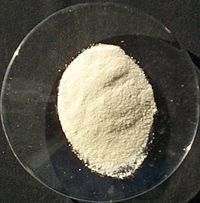
Photo from wikipedia
Whether the oxygen vacancies of heterogeneous catalysts improve their catalytic activity or not has recently been the topic of intense debate in the oxidation of hydrocarbons. We designed an effective… Click to show full abstract
Whether the oxygen vacancies of heterogeneous catalysts improve their catalytic activity or not has recently been the topic of intense debate in the oxidation of hydrocarbons. We designed an effective strategy to construct mesoporous Ni-Co mixed oxides via a ligand-assisted self-assembly approach. The surface oxygen vacancy concentrations of the mesoporous Ni-Co mixed oxide catalysts were regulated by changing the doping amount of Ni or the reduction method, and the relationship between oxygen vacancies and catalytic activity was studied. Controlled experiments and DFT calculations revealed that oxygen molecules were more favorably adsorbed and activated on oxygen vacancies to form active oxygen species. Increasing the oxygen vacancy concentration within a certain range can effectively enrich the active oxygen species, therefore improving the oxidation rate of ethylbenzene. The optimized mCo3O4-0.1NiO catalyst exhibited a remarkable catalytic activity for the solvent-free oxidation of ethylbenzene to acetophenone, typically including 68.0% conversion and 95.4% selectivity (20 mg mCo3O4-0.1NiO, 10 mL ethylbenzene, and 0.6 MPa O2).
Journal Title: Inorganic chemistry
Year Published: 2023
Link to full text (if available)
Share on Social Media: Sign Up to like & get
recommendations!